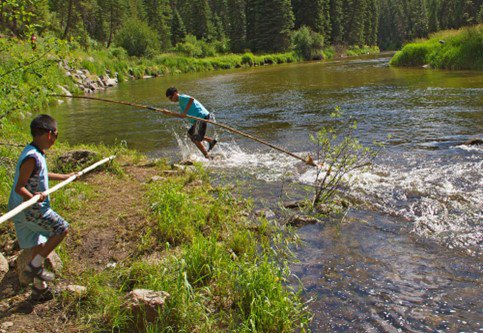Council approves next steps for the Shoshone-Bannock Tribes Waterwheel Hatchery Program and priorities for FY2025 fish screens
- June 21, 2024
- Kym Buzdygon
At its June meeting, the Council approved two actions presented to and approved by the Fish and Wildlife Committee in May. The first was to approve the Shoshone-Bannock Tribes (SBT) Waterwheel Hatchery Program’s Step 1 review so that the Tribes can begin Step 2 planning and design activities. The second was a recommendation to Bonneville to fund $1.8 million of nonrecurring maintenance for Fish and Wildlife Program fish screens in FY2025.
Shoshone-Bannock Tribes Waterwheel Hatchery Program

The Waterwheel Hatchery is designed to increase subsistence opportunities for the Shoshone-Bannock Tribe to harvest Yellowstone Cutthroat Trout, as well as contribute to the conservation and production of Snake River spring/summer Chinook in Yankee Fork and Panther Creek, tributaries of the Snake River in Idaho. The hatchery operations will be developed on tribal land on the Fort Hall Reservation, near Pocatello.
Historically, the Shoshone and Bannock peoples harvested salmon and trout throughout the Columbia River Basin for subsistence; they maintained fishing rights under the Fort Bridger Treaty of 1868. Fishing opportunities for the tribes have starkly diminished due to the hydropower system and earlier overfishing in the lower Columbia River. Current salmon abundance in the upper Salmon River Basin is estimated at 0.5% of historical runs; recent harvest opportunities for tribal members have provided only half a pound of salmon per member compared to the historical 700 pounds per person. Tribal members are therefore seeking to restore ceremonial and subsistence fishing opportunities.
The project’s path has not been straightforward, with earlier plans for artificial production facilities failing to come to fruition due to a variety of factors. Most recently, water quality issues at a previously designated location in 2019 raised significant concerns about survival rates that resulted in the selection and acquisition of a new location, the Waterwheel property.
Fish and Wildlife Deputy Director/Resident Fisheries Manager Hunter Osborne of the Shoshone-Bannock Tribe said, “We believe the project proposal, decades in the making, certainly spanning my career here with the Tribe’s Fish and Wildlife [for] 30-plus years, has merit and a basis for success backed by years of experience.”
Under the Council’s Fish and Wildlife Program, certain projects require a 3-step review process and Council approval is needed to advance between steps. Step 1 is the conceptual/feasibility phase; Step 2 covers proposed design and planning, and Step 3 covers final design and budget. In addition to approving the move from Step 1 to Step 2 for the Waterwheel Hatchery Program, the Council requested that the Shoshone-Bannock Tribes provide information at the Step 2 review that addresses issues raised by the Independent Science Review Panel in its 2023 review.
Asset Management Strategic Plan fish screen priorities for FY25
The 2014 Fish and Wildlife Program recommended prioritizing long-term maintenance of assets funded in previous years by the Program. An Asset Management Strategic Plan was developed in collaboration with Bonneville to address these non-recurring maintenance needs for fish screens, fish hatcheries, and mitigation lands. As part of the annual process associated with the Asset Management Strategic Plan, funds from BP24 Integrated Program Review (IPR) were made available to address non-recurring needs for the Fish and Wildlife Program fish screens in FY2025. The Council approved the recommendation to Bonneville that it implement this request.



